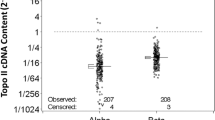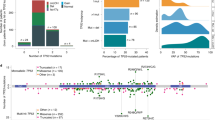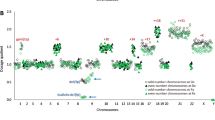Abstract
The molecular effects of etoposide in haemopoietic cells suggest that mixed lineage leukaemia (MLL) abnormalities can be biomarkers of patient susceptibility to the genotoxic effects of topoisomerase 2 (topo 2) inhibitors. We have prospectively studied treatment-related MLL cleavage and rearrangement in serial samples from 71 children receiving chemotherapy, using Southern blot analysis and panhandle PCR. The results were related to patient demographics, treatment details and outcome. MLL cleavage was identified in six bone marrow samples from five patients 2–10 months after the start of therapy. There was no obvious relationship between the degree of MLL cleavage and cumulative dose or schedule of topo 2 inhibitors. Three children with low percentage (23–30%) cleavage remained well and two were still receiving treatment at study completion. One child with two consecutively positive samples and higher level of MLL cleavage (45–48%) died from treatment-related toxicities and relapsed leukaemia. A patient with haemophagocytic lymphohistiocytosis developed the highest level of MLL cleavage (50%) at 3 months and a treatment-related leukaemia with MLL rearrangement 6 months after the start of treatment. It would appear that some patients are inherently more susceptible to the genotoxic effect of topo 2 inhibitors. The degree and persistence of MLL cleavage may identify patients at risk.
This is a preview of subscription content, access via your institution
Access options
Subscribe to this journal
Receive 12 print issues and online access
$259.00 per year
only $21.58 per issue
Buy this article
- Purchase on Springer Link
- Instant access to full article PDF
Prices may be subject to local taxes which are calculated during checkout



Similar content being viewed by others
References
Pui CH, Ribeiro R, Hancock M, Rivera G, Crist WM, Evans W et al. Acute myeloid leukemia in children treated with epipodophyllotoxins for acute lymphoblastic leukemia. N Engl J Med 1991; 325: 1682–1687.
Pui CH, Relling MV, Rivera GK, Hancock ML, Raimondi SC, Heslop HE et al. Epipodophyllotoxin-related acute myeloid leukaemia: a study of 35 cases. Leukemia 1995; 9: 1990–1996.
Sandler ES, Friedman DJ, Mustafa MM, Winick NJ, Bowman WP, Buchannan GR . Treatment of children with epipodophyllotoxin-induced secondary acute myeloid leukemia. Cancer 1997; 79: 1049–1054.
Felix CA . Secondary leukemias induced by topoisomerase-targeted drugs. Biochim Biophys Acta 1998; 1400: 233–255.
Leahey AM, Friedman DL, Bunin NJ . Bone marrow transplantation in pediatric patients with therapy-related myelodysplasia and leukemia. Bone Marrow Transplant 1999; 23: 21–25.
Pui CH, Relling MV . Topoisomerase 2 inhibitor-related acute myeloid leukemia. Br J Haematol 2000; 109: 13–23.
Ng A, Taylor GM, Eden OB . Treatment-related leukaemia – a clinical and scientific challenge. Cancer Treat Rev 2000; 26: 377–391.
Aplan PD, Chervinsky D, Stanulla M, Burhans W . Site-specific DNA cleavage within the MLL breakpoint cluster region induced by topo 2 inhibitors. Blood 1996; 87: 2649–2658.
Strissel Broeker P, Gill Super H, Thirman M, Pomykala H, Yonebayashi Y, Tanabe S et al. Distribution of 11q23 breakpoints within the MLL breakpoint cluster region in de novo acute leukemia and in treatment-related acute myeloid leukemia: correlation with scaffold attachment regions and topoisomerase 2 consensus binding sites. Blood 1996; 87: 1912–1922.
Felix CA, Jones DH . Panhandle PCR: a technical advance to amplify MLL genomic translocation breakpoints. Leukemia 1998; 12: 976–981.
Megonigal MD, Cheung NKV, Rappaport EF, Nowell PC, Wilson RB, Jones DH et al. Detection of leukemia-associated MLL-GAS7 translocation early during chemotherapy with DNA topoisomerase 2 inhibitors. Proc Natl Acad Sci USA 2000; 97: 2814–2819.
Felix CA, Lange BJ, Hosler MR, Fertala J, Bjornsti MA . Chromosome band 11q23 translocation breakpoints are DNA topoisomerase 2 cleavage sites. Cancer Res 1995; 55: 4287–4292.
Lovett BD, Nigro LL, Rappaport EF, Blair IA, Osheroff N, Zheng N et al. Near-precise interchromosomal recombination and functional DNA topoisomerase 2 cleavage sites at MLL and AF4 genomic breakpoints in treatment-related acute lymphoblastic leukemia with t(4;11) translocation. Proc Natl Acad Sci USA 2001; 98: 9802–9807.
Lovett BD, Strumberg D, Blair IA, Pang S, Burden D, Megonigal MD et al. Etoposide metabolites enhance DNA topoisomerase 2 cleavage near leukemia-associated MLL translocation breakpoints. Biochemistry 2001; 40: 1159–1170.
Domer PH, Head DR, Renganathan N, Raimondi SC, Yang E, Atlas M . Molecular analysis of 13 cases of MLL/11q23 secondary acute leukemia and identification of topoisomerase 2 consensus-binding sequences near the chromosomal breakpoint of a secondary leukemia with t(4;11). Leukemia 1995; 9: 1305–1312.
Felix CA, Hosler MR, Provisor D, Salhany K, Sexsmith EA, Slater DJ et al. The p53 gene in pediatric therapy-related leukemia and myelodysplasia. Blood 1996; 87: 4376–4381.
Atlas M, Head D, Behm F, Schmidt E, Zeleznik-Le NH, Roe BA et al. Cloning and sequence analysis of 4 t(9;11) therapy-related leukemia breakpoints. Leukemia 1998; 12: 1895–1902.
Megonigal MD, Rappaport EF, Nowell PC, Lange BJ, Felix CA . Potential role for wild-type p53 in leukemias with MLL gene translocations. Oncogene 1998; 16: 1351–1356.
Acknowledgements
This work was supported by the Friends of Rosie Children's Cancer Research Fund, the Children Cancer Unit Research Fund and the University of Manchester. OBE is funded by the Cancer Research, UK.
Author information
Authors and Affiliations
Corresponding author
Rights and permissions
About this article
Cite this article
Ng, A., Taylor, G., Wynn, R. et al. Effects of topoisomerase 2 inhibitors on the MLL gene in children receiving chemotherapy: a prospective study. Leukemia 19, 253–259 (2005). https://doi.org/10.1038/sj.leu.2403599
Received:
Accepted:
Published:
Issue Date:
DOI: https://doi.org/10.1038/sj.leu.2403599
Keywords
This article is cited by
-
Anti-cancer therapy is associated with long-term epigenomic changes in childhood cancer survivors
British Journal of Cancer (2022)
-
Therapy-related, donor-derived AML responding to a second allogeneic BMT
Bone Marrow Transplantation (2007)
-
MLL rearrangements emerge during spontaneous apoptosis of clinical blood samples
Leukemia (2006)



